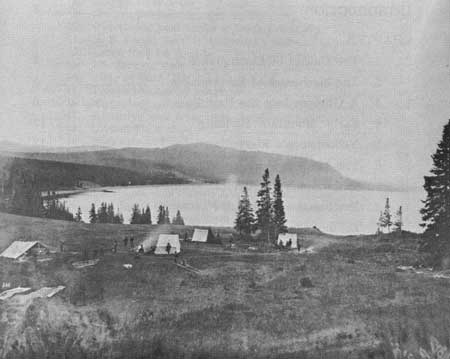|
YELLOWSTONE NATURE NOTES
|
| Vol. XXXIII |
June, 1960 |
Special Edition |
|
PREFACE
The geologic history of an area is inevitably
assembled by the labors of a number of geologists dedicated to the
search for the truth as they walk plateaus, climb mountains and descend
into canyons to decipher the fascinating story of earth history.
The complexities of Yellowstone geology are
staggering to the professional and bewildering to the layman. In the
pages that follow I have attempted to condense pertinent highlights of
the past 70 million years as they relate to an understanding of
earthquakes as a normal geologic process in Yellowstone National
Park.
For those interested primarily in the earthquake
changes there is included a map keyed to the text and with it one can
reconstruct the sequence of events that began on the night of August 17,
1959.
"I have no doubt that if this part of the country should ever be
settled and careful observations made, it will be found that earthquake
shocks are of very common occurrence"1
1F. V. Hayden, 1872. Preliminary Report of
the United States Geological Survey of Montana and Portions of Adjacent
Areas, Part 1, p. 82.

PLATE 1. Earthquake Camp, near Steamboat Point, east side of Yellowstone
Lake, so named from several earthquake shocks experienced at this place
on the night of the 19th of August 1871. Photo by W. H. Jackson,
Courtesy of the U. S. Geological Survey film library.
ACKNOWLEDGEMENT
I am under many obligations, notably to my associates
Park Naturalists M. D. Beal, G. D. Marler, and A. T. Hewitt who have
read portions of the manuscript and kindly offered words of criticism
and encouragement.
The drafting and illustrations were very capably
executed by the talented hand of Bill Chapman; Mrs. Helen G. Minish
typed the manuscript.
Dr. Stephen W. Nile, Collaborator in Seismology for
the U. S. Coast and Geodetic Survey, Butte, Montana, has been most
cooperative in supplying seismic data from his personal files and has
faithfully answered the many questions with which I have besieged him in
recent months.
For information on the Yellowstone rhyolite plateau I
am deeply indebted to Dr. F. R. Boyd of the Geophysical Laboratory of
the Carnegie Institute, Washington, D. C., who has graciously permitted
the inclusion of some of his unpublished research.
Correspondence and conversations with Dr. Irving J.
Witkind of the U. S. Geological Survey and Dr. Kenneth L. Cook of the
University of Utah are gratefully acknowledged.
Credit is given in the text to the various
organizations and individuals who have permitted reproduction of
photographic material.
A large portion of the chapter devoted to changes in
geysers and hot springs is based upon the observations of Park
Naturalist George D. Marler.
Park Naturalists A. Mebane, B. Watson, K. Higgins, R.
Frisbee, W. Germeraad and Park Ranger R. McClelland worked through the
winter months obtaining data on post-earthquake changes in geysers and
hot springs. The detailed results of their observations will provide the
basis of a future more technical report.
The entire earthquake research project, of which this
is only a brief summary, was made possible by the National Park Service
through the efforts of Superintendent Lemuel A. Garrison and Chief Park
Naturalist Robert N. McIntyre. Colorado College granted me a leave of
absence from my regular teaching duties to participate in the study.
To Robert McIntyre I am most grateful for a critical
review of the completed manuscript. We have labored together in an
attempt to bring into proper focus this most interesting of
Yellowstone's newest attractions.
William A. Fischer
8 April 1960
Yellowstone Park, Wyoming
| 
